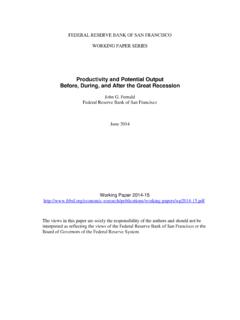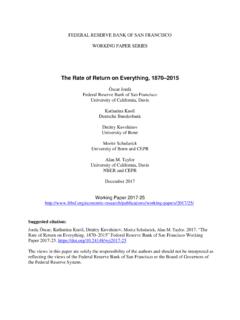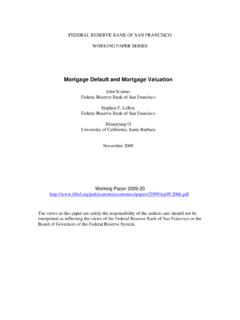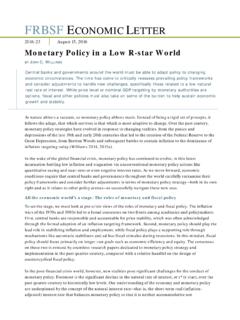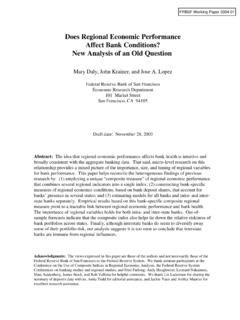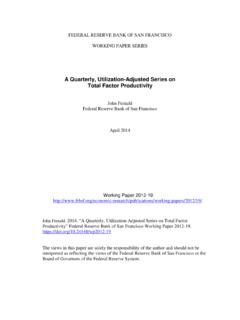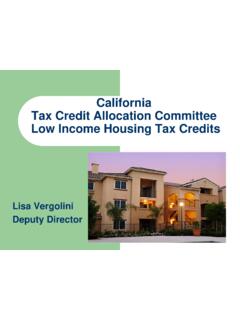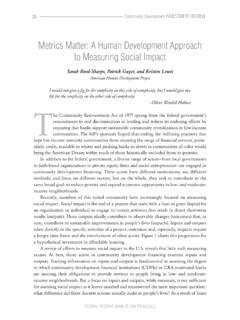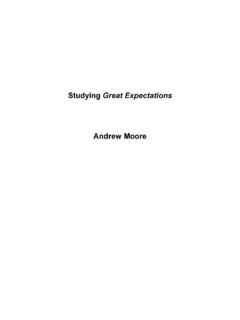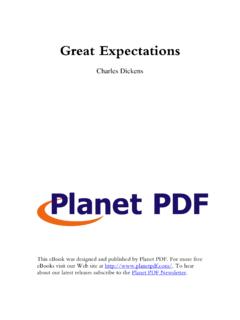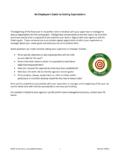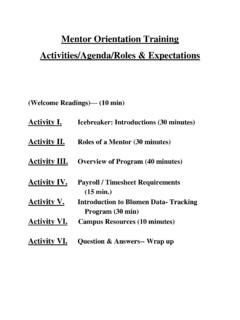Transcription of Monetary Policy Expectations at the Zero Lower …
1 FEDERAL RESERVE BANK OF SAN FRANCISCO WORKING PAPER SERIES Monetary Policy Expectations at the zero Lower Bound Michael D. Bauer, Federal Reserve Bank of San Francisco Glenn D. Rudebusch, Federal Reserve Bank of San Francisco May 2015 Suggested citation: Bauer, Michael D. and Glenn D. Rudebusch. 2015. Monetary Policy Expectations at the zero Lower Bound. Federal Reserve Bank of San Francisco Working Paper 2013-18. The views in this paper are solely the responsibility of the authors and should not be interpreted as reflecting the views of the Federal Reserve Bank of San Francisco or the Board of Governors of the Federal Reserve System. Working Paper 2013-18 Monetary Policy Expectations at the zero Lower Bound Michael D. Bauer and Glenn D. Rudebusch May 21, 2015 AbstractWe show that conventional dynamic term structure models (DTSMs) estimated on re-cent data severely violate the zero Lower bound (ZLB) onnominal interest rates anddeliver poor forecasts of future short rates.
2 In contrast, shadow-rate DTSMs account forthe ZLB by construction, capture the resulting distributional asymmetry of future shortrates, and achieve good forecast performance. These modelsprovide more accurate esti-mates of the most likely path for future Monetary Policy including the timing of policyliftoff from the ZLB and the pace of subsequent Policy tightening. We also demonstratethe benefits of including macroeconomic factors in a shadow-rate DTSM when yields areconstrained near the : dynamic term structure models, shadow rates, Policy liftoff, macro-financeJEL Classifications: E43, E44, E52 The authors thank Todd Clark, Greg Duffee, Jim Hamilton, Leo Krippner, Anh Le, Seth Pruitt, Jean-Paul Renne, Francisco Ruge-Murcia, Eric Swanson, John Williams, and Cynthia Wu, as well as seminarand conference participants at the Banque de France, the Federal Reserve Bank of San Francisco, ResearchAffiliates, UC Santa Cruz, the Bank of Canada conference Advances on Fixed Income Modeling, and theSED 2013 meetings in Seoul for their helpful comments.
3 Kevin Cook,Alison Flint and Simon Riddell providedexcellent research assistance. All remaining errors are ours. Theviews expressed in this paper are those of theauthors and do not necessarily reflect those of others in the Federal Reserve System. Corresponding author: Federal Reserve Bank of San Francisco,101 Market St. MS 1130, San Francisco,CA 94109, (415) 974-3299, Federal Reserve Bank of San Francisco1 IntroductionDivining the path of future Monetary Policy has been of special interest during the great Re-cession and its aftermath. Expectations of future Monetary Policy actions are commonly ob-tained from the term structure of interest rates, which captures financial market participants views regarding the prospective path of the short-term interestrate the Policy instrumentof central banks. Gaussian affine dynamic term structure models (DTSMs) are the standardrepresentation in finance used to extract such short-rate Expectations ( ,Piazzesi,2010).
4 However, while these models have provided good empirical representations of yield curves inthe past, they may be ill-suited to represent the dynamics of recent near- zero interest ratesthat have prevailed in many countries. In particular, standard Gaussian DTSMs do not rec-ognize that in the real world, with currency available as an alternative asset, interest rates arebounded below by zero because negative nominal interest rates would lead to riskless fact that Gaussian affine DTSMs ignore the zero Lower bound (ZLB) was of littleconsequence when interest rates were well above zero . However, as nominal interest rateshave fallen to near zero , the lack of an appropriate nonnegativity restriction in conventionalmodels has become a conspicuous theoretical deficiency. This paper presents evidence showingthat the theoretical failure of standard Gaussian affine DTSMs to account for the ZLB hasbeen an important practical deficiency in recent years in terms of fit, point and distributionalforecasting ability, and accuracy of estimated Monetary Policy Expectations .
5 Our benchmarkfor comparison is an alternative model based on the shadow-rate concept proposed byBlack(1995).2 The shadow-rate representation replaces the affine short-ratespecification of standardDTSMs with an identical affine process for an unobserved shadow short rate. The observedshort rate is set equal to this shadow short rate when it is positive;otherwise, it is set tozero (or some other near- zero minimum value). Only a few studies have used shadow-rateDTSMs that respect the ZLB, in large part because the associatednonlinearity makes itdifficult to solve for bond prices. In particular, a key advantage of affine DTSMs namely,analytical affine bond pricing is lost. Instead, numerical solution methods are required, sothe calculation of model-implied interest rates is computationally value of the Lower bound on nominal interest rates is not precisely zero . As discussed below, theeffective Lower bound depends on a variety of institutional factorsincluding the size of costs associated withstoring, transferring, and spending large amounts of , recent nominal European yields havebeen slightly negative.
6 Still, for convenience, we will describe this constraint as azerolower bound even thoughour model and analysis will allow for a non- zero Lower the ZLB, one could also consider other alternatives, such as stochastic-volatility models with square-root processes or Gaussian quadratic models, but the shadow-rate model has the advantage of matching thecanonical Gaussian DTSM when interest rates are away from the focus of our paper is the estimation of Monetary Policy Expectations at the this end, we consider both yields-only and macro-finance shadow-rate models, where thelatter includes measures of economic activity and inflation as risk factors. There is now asizable literature arguing that a joint macro-finance approach is a very productive researchavenue for term structure modeling ( ,Rudebusch,2010), but this paper is the first toinclude macroeconomic factors into a shadow-rate model. We show that when the nominalterm structure is constrained by the ZLB, the addition of macroeconomic variables to theDTSM information set is useful for inference about the future evolution of the yield , the ZLB limits the information content of the yield curve because its short end ispinned at zero .
7 In such a situation, macro variables provide important additional informationfor forecasting future yields, particularly for predicting how long the Policy rate will remainnear begin our analysis with an evaluation of affine and shadow-rate models during the pastnear-decade of very low interest rates in the United States. Giventhe close proximity of interestrates to the ZLB during this period, we find that shadow-rate DTSMs provide a statisticallysignificant and economically relevant improvement in fit and forecasting performance comparedwith standard Gaussian affine DTSMs. Affine models frequently violatethe ZLB and producesubstantial estimated probabilities of negative future short rates. Shadow-rate models avoidsuch violations by construction and fit the cross section of yields substantially better thanaffine models. Most notably, affine models cannot capture the phenomenon of the short rateremaining near zero for many years at a time, which has been the case in the United Statesand Japan.
8 Consequently, such models produce quite inaccurate short-rate forecasts at theZLB. In contrast, we document that shadow-rate models can accurately forecast prolongednear- zero Policy rates in an out-of-sample forecast models account for the substantial asymmetry in the distribution of futureshort rates during periods of near- zero Policy rates. This feature is especially valuable forassessing Monetary Policy Expectations embedded in the yield curveat the ZLB. For example,one key question is how to estimate the anticipated timing of the liftoffof the Policy rate fromthe ZLB. A common approach among financial market researchersand investors is to use thehorizon at which forward rates cross a given threshold, say 25 basis points, as an estimateof the expected date of liftoff. But forward rates correspond to(risk-neutral) Expectations offuture short rates, and this practice of using thismean pathto estimate liftoff is problematicbecause it ignores the asymmetry of the distribution of future short rates near the value of a macro-finance approach is also consistent with the many central bank statements that havestressed that the timing of liftoff from the ZLB is dependent on the flow of incoming macroeconomic , to assess the expected time of short-rate liftoff, one needs to consider themodalpath the most-likely path for future short rate rates.
9 In a shadow-rate model, this modalpath corresponds to the expected path of future shadow shortrates (or to zero when theexpected shadow short rate is negative). A comparison of the mean path to the modal pathreveals how tightly the ZLB constraint is binding. The difference between the two paths, whichwe term a ZLB wedge, reflects the asymmetry induced by the ZLB on the distribution offuture short rates. Furthermore, it also measures the option cost of the ZLB, , the valueof the option of holding physical currency. We use the ZLB wedge between the ten-year yieldand the corresponding shadow yield as a measure of the tightness of the ZLB constraint, anddocument that it increased substantially over the period from 2009to 2012, and then graduallydecreased over 2013 and 2014, a period when macroeconomic conditions improved measure Monetary Policy Expectations at the ZLB, we focus on two key metrics: thetime until liftoff and the subsequent pace of tightening.
10 In the first, the expected date atwhich the modal short-rate path escapes from near zero provides a forecast of the time untilliftoff that is optimal under an absolute-error loss function. We alsocompute the full forecastdistribution of the liftoff horizon in order to verify the modal-path-based liftoff estimate andto obtain interval forecasts for liftoff. We find that model-based liftoff estimates based ona macro-finance yield curve model closely accord with private-sector forecasts of the timingof Monetary Policy liftoff, and are consistent with the Federal OpenMarket Committee s(FOMC) calendar-based forward guidance. Overall, the liftoff horizon can therefore serve asa useful univariate summary of Monetary Policy at the second metric, the initialpace of Policy tightening is calculated as the expected cumulative increase in the modal shortrate path during the first two years after liftoff. Our macro-finance term structure modelforecasts a much more gradual increase in the Policy rate than in previous Policy tighteningcycles, which is consistent with statements by Federal Reserve , our analysis documents the empirical relevance of the ZLB constraint and the im-portance of accounting for it when carrying out inference about interest rates and monetarypolicy during the recent period in the United States.
